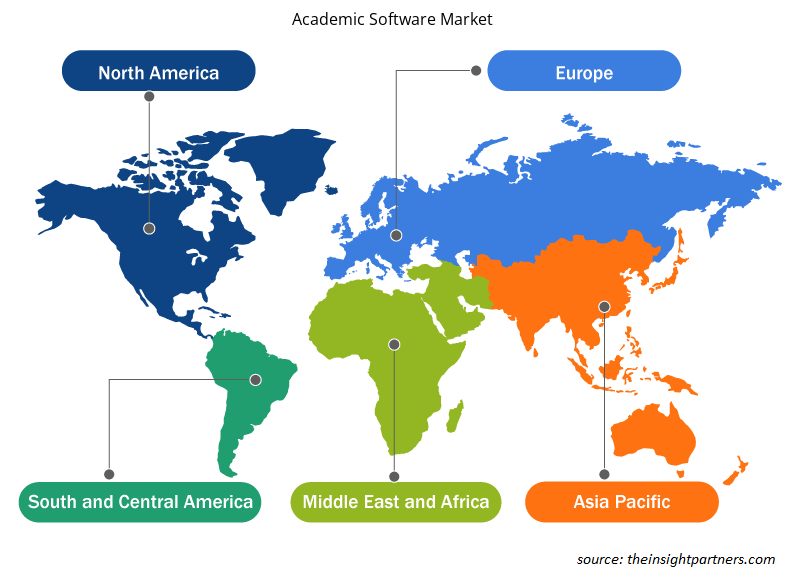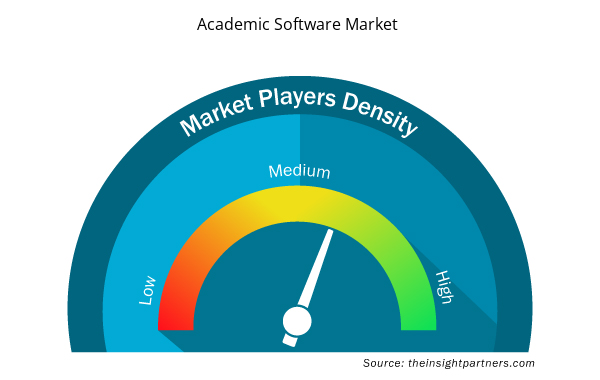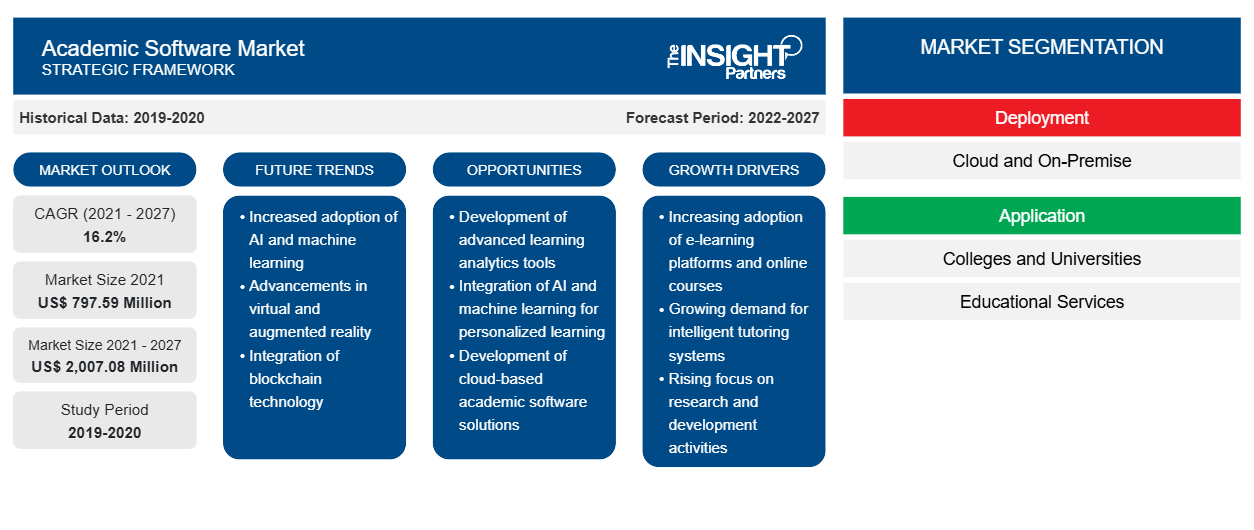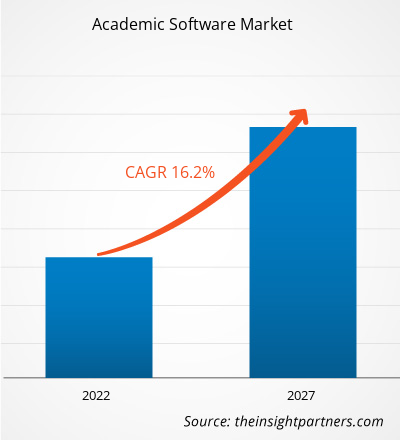Si prevede che il mercato del software accademico crescerà da 797,59 milioni di dollari nel 2021 a 2.007,08 milioni di dollari entro il 2027. Si prevede che il mercato del software accademico crescerà a un CAGR del 16,2% durante il periodo di previsione dal 2021 al 2027.
L'adozione crescente dell'eLearning tra le istituzioni è il fattore chiave che guida la crescita del mercato del software accademico. Nell'eLearning, leggendo o guardando contenuti, si sta cambiando il modo in cui viene erogata l'istruzione. Diversi corsi di eLearning come animazioni, podcast e video creano un ambiente di apprendimento multimodale e realistico. L'eLearning, i contenuti educativi aprono diverse opportunità di apprendimento immersivo per gli studenti tramite computer, laptop, tablet o smartphone. Invece di trovarsi in un ambiente passivo, gli studenti possono scegliere ciò di cui hanno bisogno per imparare facilmente e rapidamente. Questi vantaggi stanno aumentando la domanda di software accademico in tutto il mondo.
La pandemia di COVID-19 ha gravemente colpito il settore dell'istruzione in tutto il mondo. Ciò ha anche promosso l'adozione di un sistema di istruzione online in tutte le principali economie del mondo; influenzando così l'adozione di software per varie applicazioni, come la fornitura di lezioni, la gestione degli studenti e altre attività operative da postazioni remote. Pertanto, si prevede che la crescente adozione di soluzioni tecnologicamente avanzate in tutto il settore avrà un impatto positivo sulla crescita del mercato del software accademico durante la pandemia.
In base all'implementazione, il mercato del software accademico è segmentato in cloud e on-premise. Nel 2019, il segmento cloud ha rappresentato una quota maggiore nel mercato. Negli ultimi anni, il settore tecnologico ha assistito a un aumento costante dell'adozione del cloud computing. Ciò è dovuto al fatto che il cloud computing semplifica i tempi di implementazione e riduce sostanzialmente i costi di implementazione. Questo vantaggio ha attratto un gran numero di utenti finali; pertanto, la maggior parte degli operatori del mercato del software accademico fornisce prodotti basati su cloud insieme alla crescente domanda di software basati su cloud. Inoltre, l'infrastruttura Internet nei paesi sviluppati si è evoluta e sta fiorendo in molti paesi in via di sviluppo, consentendo agli utenti finali di accedere alle soluzioni basate su cloud sia nei paesi sviluppati che in quelli in via di sviluppo.
Personalizza questo report in base alle tue esigenze
Riceverai la personalizzazione gratuita di qualsiasi report, comprese parti di questo report, o analisi a livello nazionale, pacchetto dati Excel, oltre a usufruire di grandi offerte e sconti per start-up e università
- Scopri le principali tendenze di mercato in questo rapporto.Questo campione GRATUITO includerà analisi di dati che spaziano dalle tendenze di mercato alle stime e alle previsioni.
Approfondimenti sul mercato del software accademico
Integrazione di tecnologie come l'intelligenza artificiale con soluzioni software accademiche
L'intelligenza artificiale (IA) è una tecnologia che fornisce ai computer la capacità, allo stesso modo degli esseri umani, di comunicare con le persone, comprendere gli eventi e apprendere e reagire agli eventi. Nel corso degli anni, l'intelligenza artificiale non solo ha avuto enormi applicazioni in vari settori, come la sicurezza, la sorveglianza e la tecnologia informatica, ma ha anche registrato un aumento nell'adozione delle tecnologie nel settore dell'istruzione. L'IA viene adottata in scuole, college e università per automatizzare attività ripetitive, come la valutazione, l'analisi finanziaria e i processi di ammissione. Ad esempio, l'IA può essere calibrata per apprendere e modellare le azioni degli insegnanti durante la valutazione, tramite programmi per computer avanzati, come la valutazione automatica, per l'assegnazione automatica dei voti in futuro. Nel tempo, il programma apprenderà le competenze accademiche di più studenti e, in base alle loro prestazioni, preparerà piani di formazione personalizzati.
Approfondimenti di mercato basati sulla distribuzione
In base al tipo di distribuzione, il mercato globale del software accademico è segmentato in cloud e on-premise. Il software accademico basato su cloud sta assistendo a una domanda elevata rispetto al software accademico on-premise. Il segmento cloud genera la maggior parte della domanda poiché è relativamente meno costoso grazie alla solida infrastruttura di rete nei paesi sviluppati. Inoltre, i fornitori di software accademico basati su cloud sono altamente concentrati sullo sviluppo di una patch di sicurezza di alto livello per eliminare il rischio di attacchi informatici. Questo fattore sta anche creando una domanda significativa da parte degli utenti finali, guidando così il mercato del software accademico.
Approfondimenti di mercato basati sulle applicazioni
In base all'applicazione, il mercato del software accademico è segmentato in college e università, servizi educativi e altri. La crescente adozione di soluzioni moderne in istituti scolastici e università per offrire corsi sia online che offline agli studenti, insieme all'iniziativa di rendere disponibili soluzioni avanzate a tutto il personale e agli studenti, sta influenzando l'adozione del software accademico. Ciò sta alimentando la crescita del mercato nel corso degli anni.
I player che operano nel mercato del software accademico si concentrano su strategie, come iniziative di mercato, acquisizioni e lanci di prodotti, per mantenere le loro posizioni nel mercato del software accademico. Ecco alcuni sviluppi dei player chiave del mercato del software accademico:
A dicembre 2020, la piattaforma del sistema informativo per studenti Alma ha introdotto la funzionalità delle medie dei voti (GPA) che è stata aggiunta allo strumento del registro dei voti. La valutazione basata sugli standard (SBG) è radicata nell'allineamento del feedback degli studenti e della misurazione dei progressi rispetto alle competenze specifiche insegnate e valutate, piuttosto che utilizzare un singolo punteggio per coprire più argomenti o standard.
A luglio 2020, ConexED ha aggiornato la sua app iOS 2.2.3 per un'esperienza più intuitiva. Questa app consente a studenti, personale e docenti di partecipare a riunioni virtuali e videoconferenze sui loro dispositivi mobili.
Approfondimenti regionali sul mercato del software accademico
Le tendenze regionali e i fattori che influenzano il mercato del software accademico durante il periodo di previsione sono stati ampiamente spiegati dagli analisti di Insight Partners. Questa sezione discute anche i segmenti e la geografia del mercato del software accademico in Nord America, Europa, Asia Pacifico, Medio Oriente e Africa e America meridionale e centrale.

- Ottieni i dati specifici regionali per il mercato del software accademico
Ambito del rapporto sul mercato del software accademico
| Attributo del report | Dettagli |
|---|---|
| Dimensioni del mercato nel 2021 | 797,59 milioni di dollari USA |
| Dimensioni del mercato entro il 2027 | 2.007,08 milioni di dollari USA |
| CAGR globale (2021 - 2027) | 16,2% |
| Dati storici | 2019-2020 |
| Periodo di previsione | 2022-2027 |
| Segmenti coperti | Per distribuzione
|
| Regioni e Paesi coperti | America del Nord
|
| Leader di mercato e profili aziendali chiave |
|
Densità dei player del mercato del software accademico: comprendere il suo impatto sulle dinamiche aziendali
Il mercato del software accademico sta crescendo rapidamente, spinto dalla crescente domanda degli utenti finali dovuta a fattori quali l'evoluzione delle preferenze dei consumatori, i progressi tecnologici e una maggiore consapevolezza dei vantaggi del prodotto. Con l'aumento della domanda, le aziende stanno ampliando le loro offerte, innovando per soddisfare le esigenze dei consumatori e capitalizzando sulle tendenze emergenti, il che alimenta ulteriormente la crescita del mercato.
La densità degli operatori di mercato si riferisce alla distribuzione di aziende o società che operano in un particolare mercato o settore. Indica quanti concorrenti (operatori di mercato) sono presenti in un dato spazio di mercato in relazione alle sue dimensioni o al valore di mercato totale.
Le principali aziende che operano nel mercato del software accademico sono:
- Alma
- SOFTWARE PER CAMPUS CAFÉ
- ConexED
- Soluzioni Envisio Inc.
- TESSUTO COMPLETO
Disclaimer : le aziende elencate sopra non sono classificate secondo un ordine particolare.

- Ottieni una panoramica dei principali attori del mercato del software accademico
Mercato del software accademico – per distribuzione
- Nuvola
- In sede
Mercato del software accademico – per applicazione
- College e università
- Servizi educativi
- Altri
Mercato del software accademico – per area geografica
America del Nord
- NOI
- Canada
- Messico
Europa
- Francia
- Germania
- Russia
- Regno Unito
- Italia
- Resto d'Europa
Asia Pacifico (APAC)
- Cina
- India
- Giappone
- Australia
- Corea del Sud
- Resto dell'APAC
MEA
- Arabia Saudita
- Emirati Arabi Uniti
- Sudafrica
- Resto del MEA
SAM
- Brasile
- Argentina
- Resto del SAM
Mercato del software accademico – Profili aziendali
- Alma
- SOFTWARE PER CAMPUS CAFÉ
- ConexED
- Soluzioni Envisio Inc.
- TESSUTO COMPLETO
- PowerVista Software, Inc.
- Qualtrics LLC
- Società Tophatmonocle
- Vero dialogo
- Alveare magico
- Analisi storica (2 anni), anno base, previsione (7 anni) con CAGR
- Analisi PEST e SWOT
- Valore/volume delle dimensioni del mercato - Globale, regionale, nazionale
- Industria e panorama competitivo
- Set di dati Excel



Report Coverage
Revenue forecast, Company Analysis, Industry landscape, Growth factors, and Trends

Segment Covered
This text is related
to segments covered.

Regional Scope
North America, Europe, Asia Pacific, Middle East & Africa, South & Central America

Country Scope
This text is related
to country scope.
Domande frequenti
Increase in adoption of modern technologies and rapid shift from traditional teaching methodologies to modern teaching techniques are influencing the adoption of academic software solutions across colleges and universities across the globe. Additionally, software packages taken by universities and colleges for a large number of users are also cost efficient for both the institutions and the students. In the private sector, for instance, many software packages that a student wants are very expensive. This is why VIVES University of Applied Sciences has developed a partnership to deliver academic solutions with Signpost. Bulk transaction or software license transactions would substantially lower the cost of all their students' required application. A standard software package is compiled by VIVES on Signpost's Academic Software platform, which consists of hundreds of software titles that must be purchased by any VIVES student as a compulsory learning material, regardless of the education or training process. The same can be installed and used on personal laptops and desktops of students. Thus, increasing initiatives by colleges and universities to install bulk academic solutions for students are contributing to the academic software market growth across the globe.
The software industry is growing at a fast pace in the region as it attracts various technological developments. The US federal government spends ~US$ 79 billion every year on the development of primary and secondary education programs. In addition, the trend of privatizing schools in the US is prevailing which is another aspect that would help in boosting the scope of integrating advanced software in schools. In the 21st century, the education sector is experiencing numerous efforts to privatize educational services which were provided by public agencies & school systems. Privatization is expected to transform the method of running schools and will open up opportunities for integrating new software and technologies to manage operations in educational institutes efficiently.
Artificial intelligence (AI) is a technology that gives computers the ability, in the same way as humans, to communicate with people, understand events, and learn and react to events. Over the years, artificial intelligence not only had huge applications across industries—such as security and surveillance and information technology—but it had also experienced a rise in adoption of the technologies in the education sector. AI is being adopted across schools, colleges, and universities for automating repetitive tasks, such as grading, financial analysis, and admission processes. For example, AI can be calibrated to learn and model teacher actions while grading, through advanced computer programs—such as Automated Grading—for automatic grade assignment in the future. Over time, the program would learn the academic skills of multiple students and, based on their performances, prepare customized training plans.
Trends and growth analysis reports related to Technology, Media and Telecommunications : READ MORE..
The List of Companies - Academic Software Market
- Alma
- CAMPUS CAFÉ SOFTWARE
- ConexED
- Envisio Solutions Inc.
- FULL FABRIC
- PowerVista Software, Inc.
- Qualtrics LLC
- Tophatmonocle Corp
- TrueDialog
- WizeHive
The Insight Partners performs research in 4 major stages: Data Collection & Secondary Research, Primary Research, Data Analysis and Data Triangulation & Final Review.
- Data Collection and Secondary Research:
As a market research and consulting firm operating from a decade, we have published and advised several client across the globe. First step for any study will start with an assessment of currently available data and insights from existing reports. Further, historical and current market information is collected from Investor Presentations, Annual Reports, SEC Filings, etc., and other information related to company’s performance and market positioning are gathered from Paid Databases (Factiva, Hoovers, and Reuters) and various other publications available in public domain.
Several associations trade associates, technical forums, institutes, societies and organization are accessed to gain technical as well as market related insights through their publications such as research papers, blogs and press releases related to the studies are referred to get cues about the market. Further, white papers, journals, magazines, and other news articles published in last 3 years are scrutinized and analyzed to understand the current market trends.
- Primary Research:
The primarily interview analysis comprise of data obtained from industry participants interview and answers to survey questions gathered by in-house primary team.
For primary research, interviews are conducted with industry experts/CEOs/Marketing Managers/VPs/Subject Matter Experts from both demand and supply side to get a 360-degree view of the market. The primary team conducts several interviews based on the complexity of the markets to understand the various market trends and dynamics which makes research more credible and precise.
A typical research interview fulfils the following functions:
- Provides first-hand information on the market size, market trends, growth trends, competitive landscape, and outlook
- Validates and strengthens in-house secondary research findings
- Develops the analysis team’s expertise and market understanding
Primary research involves email interactions and telephone interviews for each market, category, segment, and sub-segment across geographies. The participants who typically take part in such a process include, but are not limited to:
- Industry participants: VPs, business development managers, market intelligence managers and national sales managers
- Outside experts: Valuation experts, research analysts and key opinion leaders specializing in the electronics and semiconductor industry.
Below is the breakup of our primary respondents by company, designation, and region:

Once we receive the confirmation from primary research sources or primary respondents, we finalize the base year market estimation and forecast the data as per the macroeconomic and microeconomic factors assessed during data collection.
- Data Analysis:
Once data is validated through both secondary as well as primary respondents, we finalize the market estimations by hypothesis formulation and factor analysis at regional and country level.
- Macro-Economic Factor Analysis:
We analyse macroeconomic indicators such the gross domestic product (GDP), increase in the demand for goods and services across industries, technological advancement, regional economic growth, governmental policies, the influence of COVID-19, PEST analysis, and other aspects. This analysis aids in setting benchmarks for various nations/regions and approximating market splits. Additionally, the general trend of the aforementioned components aid in determining the market's development possibilities.
- Country Level Data:
Various factors that are especially aligned to the country are taken into account to determine the market size for a certain area and country, including the presence of vendors, such as headquarters and offices, the country's GDP, demand patterns, and industry growth. To comprehend the market dynamics for the nation, a number of growth variables, inhibitors, application areas, and current market trends are researched. The aforementioned elements aid in determining the country's overall market's growth potential.
- Company Profile:
The “Table of Contents” is formulated by listing and analyzing more than 25 - 30 companies operating in the market ecosystem across geographies. However, we profile only 10 companies as a standard practice in our syndicate reports. These 10 companies comprise leading, emerging, and regional players. Nonetheless, our analysis is not restricted to the 10 listed companies, we also analyze other companies present in the market to develop a holistic view and understand the prevailing trends. The “Company Profiles” section in the report covers key facts, business description, products & services, financial information, SWOT analysis, and key developments. The financial information presented is extracted from the annual reports and official documents of the publicly listed companies. Upon collecting the information for the sections of respective companies, we verify them via various primary sources and then compile the data in respective company profiles. The company level information helps us in deriving the base number as well as in forecasting the market size.
- Developing Base Number:
Aggregation of sales statistics (2020-2022) and macro-economic factor, and other secondary and primary research insights are utilized to arrive at base number and related market shares for 2022. The data gaps are identified in this step and relevant market data is analyzed, collected from paid primary interviews or databases. On finalizing the base year market size, forecasts are developed on the basis of macro-economic, industry and market growth factors and company level analysis.
- Data Triangulation and Final Review:
The market findings and base year market size calculations are validated from supply as well as demand side. Demand side validations are based on macro-economic factor analysis and benchmarks for respective regions and countries. In case of supply side validations, revenues of major companies are estimated (in case not available) based on industry benchmark, approximate number of employees, product portfolio, and primary interviews revenues are gathered. Further revenue from target product/service segment is assessed to avoid overshooting of market statistics. In case of heavy deviations between supply and demand side values, all thes steps are repeated to achieve synchronization.
We follow an iterative model, wherein we share our research findings with Subject Matter Experts (SME’s) and Key Opinion Leaders (KOLs) until consensus view of the market is not formulated – this model negates any drastic deviation in the opinions of experts. Only validated and universally acceptable research findings are quoted in our reports.
We have important check points that we use to validate our research findings – which we call – data triangulation, where we validate the information, we generate from secondary sources with primary interviews and then we re-validate with our internal data bases and Subject matter experts. This comprehensive model enables us to deliver high quality, reliable data in shortest possible time.


 Ottieni un campione gratuito per questo repot
Ottieni un campione gratuito per questo repot